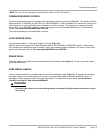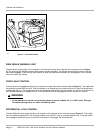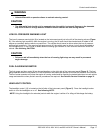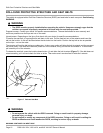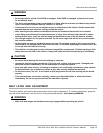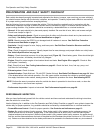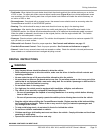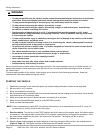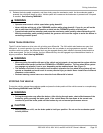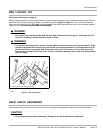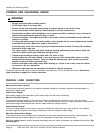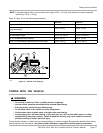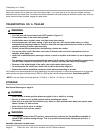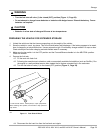
Driving Instructions
WARNING
• To help prevent falls from the vehicle, remain seated with seat belt fastened and hold on to hand holds
at all times. Driver should keep both hands on the steering wheel when the vehicle is in motion.
• To help prevent the possibility of serious injury, keep entire body inside the vehicle.
• To help prevent overturning the vehicle, drive slowly in turns.
• To help prevent overturning the vehicle, drive slowly straight up and down slopes. Avoid driving
the vehicle on slopes exceeding 20% incline.
• Avoid stopping a loaded vehicle on a hill. If a loaded vehicle must be stopped on a hill, avoid
sudden starts or rolling backwards and stopping suddenly. Failure to heed this warning could result
in overturning the vehicle.
• To help avoid possible injury to inattentive passengers and (or) damage to the vehicle, avoid sudden
starts, sudden stops, and abrupt turns.
• To help avoid the possibility of losing control of or overturning the vehicle, reduce speed for adverse
driving conditions such as wet grass or rough terrain.
• Do not use the vehicle on public roads. It is neither designed nor intended for street use and should
not be licensed for use on public roads.
• The vehicle should be driven in only specied areas by trained drivers.
• Do not drive while under the inuence of alcohol, drugs, or medications.
• Use brakes to reduce speed when coasting downhill.
• Never attempt jumps.
• Keep away from drop-offs, steep slopes, and unstable surfaces.
• Avoid extremely hard braking in reverse.
No one should drive the vehicle without rst being instructed in the proper operation and use of vehicle controls. An
experienced operator should accompany each rst-time driver on a test drive before allowing the driver to operate
the vehicle alone.
To ensure safe operation of the vehicle, follow exactly and in order all of the following procedures. Read and
understand all instructions before driving the vehicle.
STARTING THE VEHICLE
1. Read safety warnings on the instrument panel and vehicle loading information located in the cargo bed.
2. Be sure load, if any, is secure.
3. Study and understand all controls.
4. Be sure all passengers are seated with their seat belts fastened and are holding on to hand holds. Driver should
have both hands on the steering wheel.
5. Make sure wheels are turned in desired direction and nothing is in your path.
6. Make sure the Forward/Reverse handle is in the NEUTRAL position.
7. Press and hold the brake pedal.
NOTE: If the air temperature is below 65°F, the choke will be required. At air temperatures above 65°F, it may not
be necessary to use the choke to start the engine.
8. Start the vehicle: Turn the key to the START position and hold it there until the engine starts. Activate the choke
as necessary. If the engine does not start after 10-15 seconds, release the key and repeat the procedure. Once
the engine starts, release the key and it will return to the ON position. The engine will idle in neutral.
9. Release the park brake.
10. Keep the brake pedal engaged, and select direction of travel by placing the shift handle in the desired position
(Figure 5, Page 14). The engine must be at idle before the shift handle is moved.
Page 22 2009 HUV 4214, HUV 4414, andHUV 4414-XP Owner’s Manual




